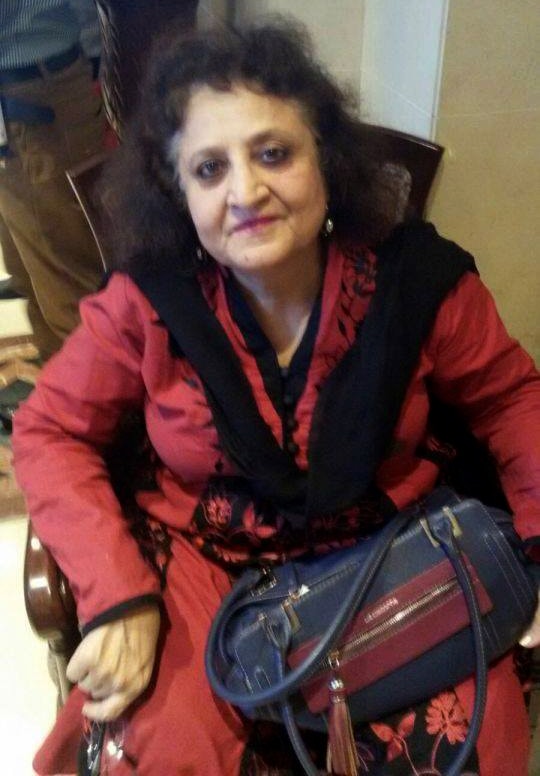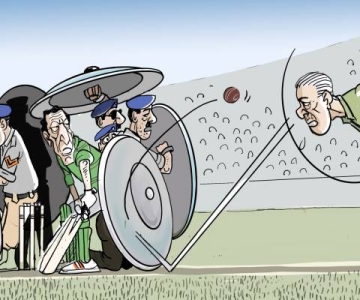Neelam Ahmad Basheer is best known as a short story writer with a new voice in Urdu fiction. She has been writing all her life but established herself after she moved back to Pakistan from the United States during the 1980s. She spent a “lifetime” in the US married to a doctor who was not appreciative of her writing talents. And, we now know her better through the publication of Char Chaand (four moons) – a collection of autobiographical sketches and essays on her life, family and friends. Barring a few exceptions, few women venture to be as candid in Urdu writing as Neelam is in her new book. There is certainly no glorification, self-promotion or desperation to weave a halo around her persona. In fact, the author emerges as a vulnerable, melancholic and nostalgic character at the outset. The honest and self-fledgling tone of these sketches makes Char Chaand more than just a memorable book. It is in fact a testament to the tribulations of middle class women in private and public spaces and the kinds of struggles they have to wage to survive in a patriarchal society such as Pakistan.
Neelam’s greatest and perhaps the most ever-lasting influence is her father late Ahmad Basheer, a revolutionary writer, journalist and film-maker who was widely respected in Lahore’s literary and journalistic circles. One gets to know him through Neelam’s loving recollections in Char Chaand, also the title of the leading sketch. The four moons here are Neelam and her sisters: the uber-talented Bushra Ansari, Sumbal, a singer and known TV persona now; and Asma who has made her name in performing arts (but is unforgettable for her legendary performance in the famous parody of Malika Pukhraj and Tahira Syed with Bushra Ansari). Neelam weaves the narrative as if it were a piece of fiction and recreates her inner sanctum where this well-knit family lives in a relatively more tolerant Pakistan. It is amazing to read that Ahmad Basheer Saheb insisted that his wife should be trained in classical music; and an Ustad was hired for this purpose. The four girls grew up with this set of highly cultured parents. Ahmad Basheer was also a radical man at home. Neelam recounts how she was forced to go out of the house by the father when she was a teenager to run errands and how petrified she was to travel alone in a bus. Remarkable for the urban middle class culture where unmarried girls rarely leave the house without a male companion. Neelam is brutally honest about her insecurities growing up with prettier and bolder sisters who are eccentric in their own ways. She tells us how quiet and responsible she was as the eldest them of all.
“Sadly, love is but an illusion… she became a Gopi for her Krishna, started to dance around him; and turned into a bhanwra. She thought that Krishna would also love her and join the dance but when she opened her eyes, she realised that her dance had been a lonely endeavour”
The idyll of Basheer household however begins to founder at the rocks of Pakistani society when the girls grow up and have to conform to the standards set by society. Most notably, they all have to be married and one by one they go through an overdose of brutish realities of contemporary Pakistan. Neelam removed from her context, later wrote, imagined stories and find ways to reinevent herself. And thus emerged a seasoned storyteller. Sumbal found herself in a conventional household where her passion for singing was almost forbidden and she had to sing in the bathroom! The advice was that if the neighbours heard you singing, they would suspect her credentials.
The idyll of Basheer’s household however begins to founder at the rocks of Pakistani society when the girls grow up and have to conform to the standards set by society
Perhaps the most revealing portions relate to the story of Bushra Ansari who makes millions laugh as Pakistan’s best comedienne; and is widely acknowledged as a marvelous actor. Neelam traces the evolution of Bushra Ansari as a performing artiste and how her competitive nature propelled her to excel in her chosen profession. But the story of Bushra’s marriage is not that enviable either: “She [Bushra] always had the passion to love and be loved, more than anything else; she wanted to ‘live’ in a state of love and be enveloped by it. Sadly, love is but an illusion… she became a Gopi for her Krishna, and started to dance around him and turned into a bhanwra. She thought that Krishna would also love her and join the dance but when she opened her eyes, she realised that her dance had been a lonely endeavour, only the earth moved with her. Krishna was enjoying the dance but kept sitting until he became a god cast in stone…gradually her feeling of being unloved started to kill her and she drowned herself in a sea of unhappiness.” This dramatic tale has a twist too and that is of the beloved being more interested in the riches Bushra attained than anything else. However, we also find out that Bushra has handled all these personal traumas rather well and her innate confidence and ability to love have only expanded over the year.
The fourth ‘chaand’ – Asma – was luckier than her sisters in seeking personal happiness. Her husband was also close to Ahmad Basheer and remains a supportive husband and a happy member of this extraordinary family. Neelam ends the sketch with sobering thoughts: “When we lived in Karachi, the girls were young. Ahmed Basheer was fond of music and composers, singers frequented the house. Musical instruments were everywhere in the house. When we shifted to Lahore, people said: “bring other decoration pieces, otherwise no suitors would come for these [four] girls”.
Like her father, the author is a staunch secularist: ” Our society has no clue that an aesthetic consciousness is a sign of intellectual maturity. Secular values teach us that humans never die. These values continue to enrich human beings… the glories of universe are hidden in the spirit of the arts, they keep us content and brighten the world. We don’t exist just to eat and drink but to experience a unique existence and this experience is life.”
Throughout the book, Neelam’s tone never becomes pathetic and rarely she indulges in self-pity. In fact, the underlying theme of personal experiences is the sheer strength and resilience of women.
“Our father should have warned us that as women, we should never ask for unconditional love, never express the desire to be loved or be ourselves…”
The other woman who lives through the book is Neelam’s aunt who is more of a friend, guide and literary companion than a relative. Ahmed Basheer’s sister Parveen Atif is another accomplished writer in Urdu and a progressive woman in her own right. Parveen’s inspiration has been her brother and this perhaps explains how she became a master story teller, a columnist, travel-writer and activist. Neelam’s narrative brings out the child, the early influences and the innate romanticism of Parveen Atif. Most importantly, the central role she continues to play in her life. It is an eminently readable write up and we explore Parveen Atif’s life and works with lots of references from Gautama Buddha and other references from our shared Indo-Muslim heritage. Both these characters also suffered their shares of personal dissatisfactions, longings and recourse to writing as a therapeutic process.
It is a strange coincidence that I finsihed reading the powerful sketch on Pakistani poet-writer Ifti Naseem the same day Naseem died in Chicago. I barely knew Naseem other than through a few email exchanges, but Neelam’s recollection brought forth a larger than life character which made me wonder how could I not have met this intriguing man. Alas, I will never meet him. But Neelam’s portrayal written in a completely honest manner is a memorable piece in Urdu literature. Entitled “Khushia”, the sketch delves into Naseem’s life, sexuality, creativity and the bohemian lifestyle which Neelam writes from a totally desi perspective. In fact, the funniest part is when Ifti tells her that he has no wife but a “life-partner” and that he was gay. Neelam admits how she was attacked by “atomic” explosions inside and tried to keep a straight face after this confession. In fact, this piece of writing is as much of an exploration of Neelam’s evolution as a tolerant Muslim Pakistani, as that of Ifti’s colourful life and adventures. She describes the parties at his Chicago apartment, his lovers and other tit bits that may not be known to many. For instance:
“Suddenly, the plastic model of a mosque started to blare azaan in Ifti’s bedroom. Ifti started to explain with seriousness, ‘The sound of azaan reminds me of my mosque in Faisalabad where I used to spend a lot of time trying to wash away my guilty thoughts and praying that God should make me like the others.. anyway, His decision.’…The cruel djinn of nostalgia was shaking him… the phone started to ring and he went to his bedroom to take the call. I guessed from the noise that he was fighting with someone on the phone. ‘Leave my husband alone’, Ifti said angrily and ended the call.”
Neelam’s humanism and open-heartedness is spread all over the narrative as she battles her conventional views on homosexuality and tries not to judge Ifti. The sketch ends with these lines: “the [Pakistani] world will not forgive Ifti because living an open, true life… and trying to be a human is also a sin”.
It is well known that the four ‘chaands’ were devoted to their father and worshipped him. But Neelam’s sketch of her father entitled “Aba Piya” (father, the beloved) transcends in style and content. It is personal, political, and honest as well. For example, when the ‘real’ world tried to break these unconventional sisters and Ahmad Basheer’s sister, they wanted to say: “Our cruel father did not teach his sister, daughters how to walk on stony paths nor the art of negotiating with complicated cliffs.. our father should have warned us that as women, we should never ask for unconditional love, never express the desire to be loved or be ourselves, and if we were to demand such things, we would be cursed and turned into stone.. [he should have told us that] you will have to learn how to cross the desert of life with sore feet”. The writing avoids taking the overtly political route as Ahmed Basheer’s political struggles are a subject of an entire volume. Neelam invents a style where the stamp of a fiction writer is evident even in a purely autobiographical piece.
Two sketches that go beyond the immediate family are about Mumtaz Mufti and Salma Awan, two eminent writers of their respective eras. Mufti was a close friend of Ahmed Basheer and the sketch by Neelam humanizes him. Most of what Mufti has written about himself suffers from a peculiar consciousness that was shared by Qudratullah Shahab, Ashfaq Ahmad, Bano Qudisa etc. who can all be categorized as self-styled, self-promoting, neo-Sufis. Neelam brings out a gentle, doting uncle who was fond of eating certain things, listening to good music, was vulnerable and above-all full of love for his nieces. It is an important read for all those who have followed Mufti’s writings.
The sketch on Salma Awan on the other hand is part-satirical and part-devotional. I have known Awan since my childhood as Salma Aunty (she is my mother’s friend and contemporary) and always admired her free spirit. Awan’s travels always fascinated me as a child and Neelam’s sketch gives a very good perspective on what motivated Awan to travel so much; and then write such minutiae of her journeys. Though ideologically very different, Awan and the author are best friends and this is a hopeful sign amid the increasingly intolerance in our society. The enjoyable bit in this sketch is where Neelam tells us that she shares the same fate as Awan. Their travels have always been devoid of “colorful, intense and interesting” accidents which could have made them tear up their return tickets. “God has his own ways to please or just ignore his creation, if He is not willing to expose us to an event which would make us run around in gardens… then we have no choice but to accept His command”.
Other than these remarkable autobiogrpahical sketches, the collection includes 6 essays which bear the same style but deal with a wide range of subjects such as travel, reflections and humour. In one of the essays, Neelam recalls her meeting with the poet Gulzar in Bombay and it is an engaging account of Gulzar’s affectionate personality. The last essay is amusing where the author is trying to reconcile with the fate of being overweight and in the process challenges stereotypes about women. Neelam’s address at a literary event organized by Kathaa, UK is refreshing for its invocation of a collective cultural Indo-Pakistani identity, something that is becoming rarer among writers from Lahore. These essays are notable for their racy prose, pithy sentences and humour. However, they cannot be compared to the initmate sketches commented above. The person who finds least mention in the book is Neelam’s brother Humayun who has been living abroad for many years. This is intriguing, but then writers pick their characters carefully.
Char Chaand comes after the publication of four collections of short stories, Ek Thi Mallika(Once there was a Princess), Gulabonwali gali (Lane of Roses), Lay Sans Bhi Ahista (Breathe, but Softly), and Sitamgar Sitambar, (a personal account of the tragedies of 9/11). In a way, it is a milestone in Neelam’s literary career where she experiments with a new genre and comes out as a victorious queen. For all the loneliness in her life, Neelam’s creativity keeps her immersed and contented. What else can a writer ask for?
Raza Rumi is a writer. His writings are archived at www.razarumi.com. Follow him on Twitter: @razarumi



